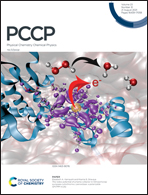A computational study of the vibronic effects on the electronic spectra and the photophysics of aza[7]helicene†
Abstract
We report a computational study on vibronic effects in the spectroscopy, photoinduced processes and decay back to the ground state of aza[7]helicene, a helicene with an unusually high fluorescence quantum yield (QY = 0.39). In a first step, we compute and assign the absorption and electronic circular dichroism (ECD) spectra in its full frequency range from 2.7 to 5.0 eV, accounting for nonadiabatic effects. Then we compute the quantum dynamics of the cascade of ultrafast internal conversions of the highly-excited singlet states to the lowest-energy one S1. Finally we adopt Fermi golden rule rates to compute the QY of the dye, taking into account the competition between the radiative decay and the nonradiative decays to the ground state and to the energy-accessible triplet states. We use time-dependent density functional theory (TD-DFT), including solvent (dichloromethane) effects within the polarizable continuum model, to parameterize a linear vibronic coupling (LVC) model involving the first lowest 12 singlet states and all the normal coordinates. Nonadiabatic spectra and internal conversions dynamics are then computed through wavepacket propagations with the Multilayer (ML) extension of the Multiconfigurational Time Dependent Hartree method (ML-MCTDH). We highlight the molecular vibrations playing a major role in determining the shape of the spectra and analyse the effect of inter-state couplings. At the same time we report a breakdown of perturbative Herzberg–Teller approach. The computed QY is in perfect agreement with experiment and allows us to ascertain that intersystem crossings are the processes limiting the fluorescence from S1. They involve the three lowest triplet states and are made effective by spin–orbit coupling and vibronic effects.
![Graphical abstract: A computational study of the vibronic effects on the electronic spectra and the photophysics of aza[7]helicene](/en/Image/Get?imageInfo.ImageType=GA&imageInfo.ImageIdentifier.ManuscriptID=D1CP00822F&imageInfo.ImageIdentifier.Year=2021)
- This article is part of the themed collection: 2021 PCCP HOT Articles


 Please wait while we load your content...
Please wait while we load your content...